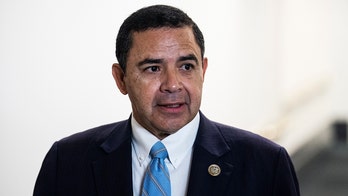
FILE - In this April 19, 2007 file photo, a lab officer cuts a DNA fragment under UV light from an agarose gel for DNA sequencing as part of research to determine genetic mutation in a blood cancer patient, in Singapore, which prides itself as an advanced medical treatment and research hub. New research shows a sharp escalation in the weapons race against cancer, with several high-tech approaches long dreamed of but not possible or successful until now. At a weekend conference of more than 30,000 cancer specialists, scientists are reporting new tactics to spur the immune system to attack a broad range of cancers, new drugs that attack the disease while sparing healthy cells, and new ways to tell which patients will benefit from which drugs. (AP Photo/Wong Maye-E, File) (AP2007)
As Republicans prepare to take the STEM Act to a House vote, the tech industry is applauding the move, but some academic experts are questioning whether it's needed.
The bill would create a new class of green cards for foreign students with advanced degrees from U.S. schools in science, technology, engineering and math.
The GOP-backed bill, which has drawn controversy because it eliminates the so-called Diversity Lottery, a program that randomly grants a green card to high school graduates from countries with low U.S. immigration rates, is set to be discussed and voted on by Friday.
Tech industry leaders hail the bill's high tech provision, which would disproportionately benefit students from Asia and Europe, as a solution to a brain drain in science, engineering, math and technology. But academics are calling into question the need for such a bill, saying there isn’t evidence to support the assertion that there is a workforce shortage in those fields.
On Capitol Hill, the bill has drawn fire from Democrats who don’t think the diversity visa program needs to be lost to create new immigration slots. Republicans have, in turn, accused Democrats of not being able to work across party lines to work on immigration reform.
In the diversity visa program, applicants can enter a lottery if they are from a country such as Guatemala or Macau, which sent less than 50,000 immigrants to the U.S. over the last five years. Most of the countries that benefit are in Africa. They are required to have a high school diploma and job that requires at least two years of training.
However, if the House and Senate pass the proposed legislation, those immigration slots would go to foreign students who would be given a green card that will allow them a pathway to citizenship if they obtain a graduate degree from a U.S. school in science, technology, engineering or math.
“The best and brightest people come to study here each year and then we ask them to go home,” said Russell Harrison, senior legislative representative from Institute of Electrical and Electronics Engineers-USA, whose professional association supports the proposal. “That doesn’t make any sense economically. It’s in our interest to let them stay and let them be part of this country rather than compete against us.”
In 2011, there were 286,066 STEM students, according to a study released by IEEE that pulled data from the U.S. Department of Homeland Security and the Student Exchange and Visitor Program. Of those, 237,356 were from Asia, the next highest sender was Europe, with 16,397 students. Mexico sent 3,022 students, Colombia sent 1,609, Brazil sent 1,336 and Argentina sent only 290.
Some within the technological industry have expressed concern that the U.S. is suffering a scarcity of qualified candidates in scientific and mathematical fields.
Microsoft issued a paper in September cautioning that “too few American students are achieving the levels of education required to secure jobs in innovation-based industries.” They called on government to work on what they claimed would be a shortage in the workforce if immigration reform was not passed.
Analysts say to take the alarming claims made in the paper – and echoed on Capitol Hill – with a grain of salt.
“There is a lot of consensus on the left and the right about wanting to increase the number of STEM visas,” said Daniel Costa, immigration policy analyst for the Economic Policy Institute. “I don’t know that sort of consensus and desire is based in fact.”
Costa said the call for increased visas comes during a time when unemployment in the computer industry is much higher than it was pre-recession. He argues that adding more workers to the job pool right now will only keep wages low and add to unemployment, adding that the move should be considered when the economy is more stable.
B. Lindsay Lowell from Georgetown University and Hal Salzman from the Urban Institute did a study recently to determine whether there was in fact a lack of supply in American science and engineering students.
They found that the number of American graduates were increasing in those subjects and performing better than they had in the past, prompting the authors to conclude “purported labor market shortages for scientists and engineers are anecdotal and also not supported by the available evidence.”
While politicians on Capitol Hill are united in their support for the tech industry that there will be a need for more STEM graduates, they are divided mostly along party lines over this bill, which is making its second appearance in the House. In September, through a set of convoluted rules, it did not receive a required two-thirds majority to pass because many Democrats did not back the plan.
Supporters have said that removing the Diversity Visa, the main source of contention for opponents, to give more educated workers a chance at a green card may ultimately better for the country.
“There are shortages in the STEM field and this will help us fill the shortages and address the future needs of our economy,” said Rep. Henry Cuellar of Texas, the lone Democratic supporter of the bill.
He added that he sees this bill as bellwether to determine which Republicans might be open to broader immigration reform.
Across the political aisle, the bill’s sponsor, Rep. Lamar Smith, says the proposal is good policy.
“We cannot afford to educate these foreign graduates in the U.S. and then send them back home to work for our competitors,” the Texas Republican said in a statement. “For America to remain the world’s economic leader, we must have access to the world’s best talent.”
Smith is expected to reintroduce the bill with a few changes, including allowing family members of permanent residents to live in the US while they wait for their Green Cards to be processed. That provision of the bill is expected to benefit Latinos more than the STEM portion of the bill.
Even with the changes, Democrats question the motives behind the bill and are expected to continue to oppose it on its second introduction.
“The minor changes Republicans have made to their bill are window-dressing at best,” said Rep. Steny Hoyer, a Maryland Democrat.
When the bill was originally proposed in September, a flurry of competing proposals hit the table, including one by Rep. Zoe Lofgren, of California, the top Democrat on the House Immigration Subcommittee and one by Sen. Chuck Schumer, New York Democrat, which would not have cut the Diversity Visas. Smith’s bill will now just need a simple majority to pass the House, but it is not expected to make it through the Democratic-controlled Senate.
Democrats charge that the bill prohibits unused green cards from being reallocated to other programs and could be lost over time, resulting in an overall decrease in the number of visas and green cards issued.
“Republicans know they have an anti-immigrant image problem,” Lofgren said. “Yet, unfortunately, they are proceeding with the Smith bill to pretend they’re pro-immigrant, even though it is a divisive bill that actually reduces legal immigration.”




